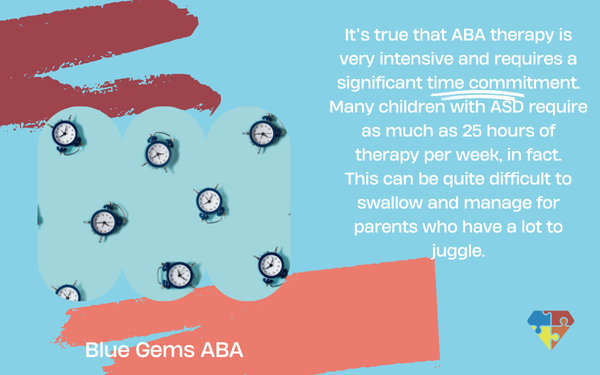Why Do Some Parents Hesitate About ABA Therapy?
If your child has been diagnosed with autism spectrum disorder (ASD), you are likely searching for the best ways in which you can support them. An autism diagnosis can certainly be a daunting thing, and can elicit a wide range of emotions.
At the end of the day, most parents just want what’s best for their child, regardless of their developmental abilities.
Today, applied behavior analysis (ABA therapy) is considered the gold standard of treatment options for children on the autism spectrum. That’s because ABA therapy is based on scientific evidence of how to teach children with ASD to gain communication and social interaction skills, while also modifying certain negative behaviors.
Despite being well-renowned as an effective treatment method, some parents still hesitate about ABA therapy.
In this article, we’ll describe some of the common objections parents have to ABA therapy.
Table Of Contents
Time Commitment and Intensity
ABA therapy has proven to be very effective at targeting certain skills and behaviors, and helping children with autism improve. Treatment programs are catered specifically to the unique strengths, challenges and preferences of each individual child, which helps therapists support each patient in the best way possible.
It’s true that ABA therapy is very intensive and requires a significant time commitment. Many children with ASD require as much as 25 hours of therapy per week, in fact.
This can be quite difficult to swallow and manage for parents who have a lot to juggle.
In addition, progress is often gradual and not instant with ABA therapy. Still, with the proper time, commitment and effort, children can overcome their challenges and achieve amazing things.

Parental Involvement
A great aspect of ABA therapy is that it directly integrates parents, family members, caregivers and other support professionals to ensure that the child is supported on a well-rounded basis at all times.
ABA therapists will teach parents and others the basics of the treatment plan, as well as how to use specific strategies and tools to ensure the skills taught in sessions are emphasized outside of sessions. This constant reinforcement helps to provide the support the child needs to gain skills and modify behaviors.
While this is a positive and differentiating aspect of ABA therapy, it also requires a direct time commitment from parents, family members and others. As mentioned before, this can be quite challenging for parents, many of whom must manage other aspects of life such as work and other children.
Still, if a proper balance can be found, ABA therapy can help children with ASD live more independently over time.
Belief of Common Myths
While much positive information about ABA therapy has been shared in recent years, there are still some myths and stigmas about it that exist. One is that therapists use punishment as a way to deter patients from exhibiting certain negative behaviors.
Many, many years ago, punishments were integrated as part of ABA therapy. That is no longer the case, though.
Today, ABA therapy only uses positive reinforcement to reward children for learning new skills and exhibiting desired behaviors, rather than punishing them. This could include extra praise or time with a toy they love, and not withholding things from them that they want.
Cost and Access
Since ABA therapy requires such a significant time commitment and is a specialized treatment, it can be a significant expense as well. Some parents look at the potential price tag of ABA therapy and have reservations about it as a result.
Many states have passed autism insurance laws, though, that require most insurance plans to provide autism-related services to those who need it. This typically includes ABA therapy for children who are officially diagnosed with ASD.
Each individual insurance plan offers different coverage levels, though, so make sure to check your plan to see what coverage you might qualify for.
Another reason for hesitation is access to quality ABA therapy resources. Some people who live in remote or rural areas may not have easy access to ABA therapy clinics or practitioners, which could turn them off from the therapy in general.
While this is unfortunate, an increasing number of people are working toward gaining RBT and BCBA certification every day, which hopefully will work to solve this problem in the near future.
| Concern | Description | Key Takeaway |
|---|---|---|
| Time Commitment | ABA therapy often requires up to 25 hours per week, making it intensive and potentially difficult to manage alongside other family responsibilities. | While demanding, the commitment can lead to meaningful, long-term developmental gains. |
| Parental Involvement | Therapists work closely with parents and caregivers to reinforce therapy goals at home, which enhances treatment effectiveness. | Engaging with the process can empower families and provide consistent support for the child. |
| Myths & Misconceptions | Outdated beliefs about punishment-based methods still influence perceptions, despite modern ABA’s exclusive use of positive reinforcement. | Current ABA focuses on rewarding desired behaviors, not punishing undesirable ones. |
| Cost and Access | Therapy can be expensive and hard to access in rural areas, though insurance coverage has expanded in many regions. | Insurance may help cover costs, and workforce expansion is improving accessibility. |
Blue Gems ABA Supports Children on the Autism Spectrum
Some parents are hesitant about ABA therapy for the reasons listed above. Still, the treatment has proven extremely effective for children who have ASD.
At Blue Gems ABA, our team of experienced therapists work one-on-one with children every day, helping them gain the social and communication skills with which they commonly struggle. By doing so, we help them live happy, healthy, productive and fulfilling lives, as independently as possible.
To learn more, please contact us today.




